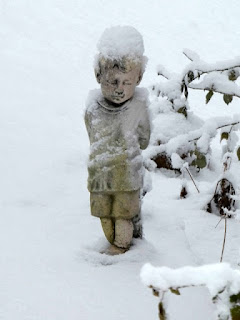Preparing Hydrangeas for Winter
Boy Caught in Snowstorm
We
have had a few nights where the temps have dropped in to the high 30s, a stark
reminder that it’s time to prepare to wrap some of my bigleaf (macrophyllas) and
mountain (serratas) hydrangeas for winter. Those that aren't planted in
protected locations as I described in my other blog posts, https://bit.ly/2lRGNlm and https://bit.ly/2A8tzZE need
a little help if I want to give them their best chance of having their buds
make it through the coming winter to see flowers in 2020.
Exactly
what does this mean right now? SHRUB COVERS: something to safely protect
the plants from ice and snow, maybe even give them a few degrees of insulation.
WHEN TO USE SHRUB COVERS
The objective of shrub covers is to make your plant think it lives
in a warmer zone or to insulate it from fluctuating temps that can blast the
flower buds. Of course, you need to
wait until your plants have dropped all their leaves on their own before you
can cover them. That leaf drop signals the plant is fully dormant. Take the
time after leaf drop to clean up the base of the plant to prevent fungal spores
from overwintering. That small chore will stop the spores from reinfecting your
plants next season. This is also a great time to add some mulch to keep
moisture in and prevent the plant from heaving during warm spells you might
have.
Taking
the need for dormancy into account, it may be too early in your part of the
country to install these covers. But it's not too early to get those shrub
covers lined up 'cause by the time you need them, you might not
have enough time to get it all done.
WHAT DOES
A SHRUB COVER LOOK LIKE?
A-FRAME VERSION
A
shrub cover can be a simple A-Frame made from discarded wood pallets you can
salvage from local stores or one you build on your own.
A-Frame shrub cover made from a pallet.
DIY plans and ideas are all over the internet. I found one at
You can leave the A-Frame bare to shunt off snow and ice. However,
for colder areas the A-frame makes a great base to drape a tarp or insulating
cover. If you do that, make sure you secure it against the weather with string
or a bungee cord.
Another kind of winter protection can be an unframed drape held by
the stems of the plant. Here's one available at several on-line shopping sites:
Unstructured shrub cover draped over
plant.
DIY CAGE VERSION
A third and very popular shrub cover is a DIY version made with
chicken wire and a few stakes. You build a cage larger than your plant and then
stuff the opening with leaves, straw, pine needles, etc. making sure you get
the insulating materials down and around the bare stems. This takes a bit of
care as you want to avoid damaging the tips where the sleeping buds lie. Depending
on where you live and where your plant is sited, you may want to insulate the outside
of the cage with bubble wrap or some other material. Also note that your
packing materials will settle during the winter so many gardeners secure a cover
over the top of structure. You can cut a piece of Styrofoam (from craft stores)
to fit above the cage and secure it to the chicken wire with twisties or bungee
cords. Barring that, you can keep an extra supply of bagged leaves at the ready
to top off your masterpiece from time to time.
DIY Cage for Hydrangea
Let the plants harden off over the next few weeks while you get things
ready. Don't wait for the last minute when time is short to get these items
lined up for installation. There's no way of telling when the on-line suppliers
will run out and how much time you have to get yourself organized for this
task. You can be ready to spring into action more quickly when you have your
covers all planned out and ready to go. Plus it is more pleasant to work
outside now before the temps really plunge.
I cover the subject of winter protection in my best selling
book, Success With Hydrangeas, A Gardener's Guide. You can order a
signed copy here. It
makes a great holiday gift for the gardener in your life.
Hydrangea happiness can't start soon enough!







